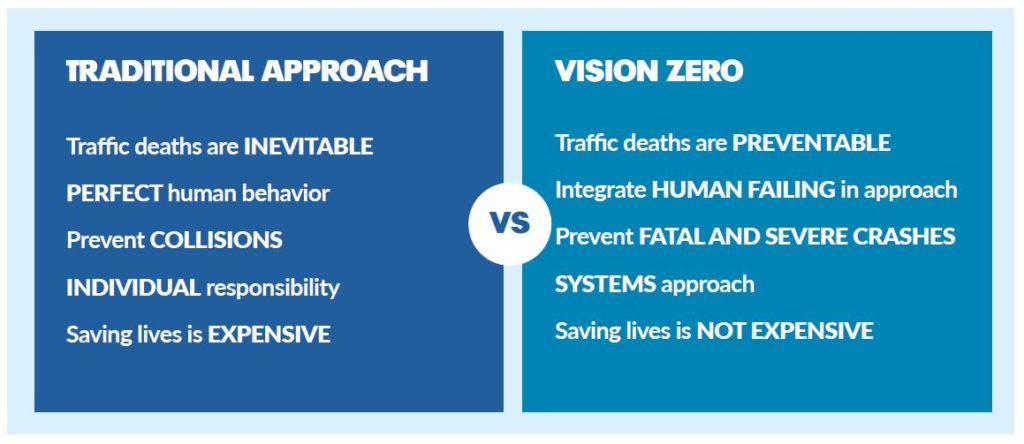In 2017 New York’s highest court upheld, in a 6-1 decision, a judgment against NYC in a case in which a young cyclist was struck and killed by a criminal motorist. The case was crystal clear against the driver. The motorist had a long, ugly history of bad driving – speeding -driving without a license. But the family’s attorney took another approach- an extraordinary argument. He sued the city …claiming the city’s failure to apply some traffic calming measures to a street KNOWN to be horribly dangerous was a contributing factor to the crash… The Jury agreed, assigning 50% liability to NYC, 40% to the motorist and 10% to the young boy who was killed while riding at night.
The case – Torturro v. City of New York – was a 6-1 decision from NY’s highest court. It held, in essence, that NY cities faced possible tort liability to victims of crashes.
Greg Shill wrote a short summary of the case here – https://papers.ssrn.com/sol3/papers.cfm?abstract_id=2961099
Anyone arguing in favor of a “Vision Zero” policy should know this case backwards and forwards as it presents a road map for imposing significant liability on a city, in the right case, for failing to implement some “Vision Zero” ideas …
Plaintiff’s counsel presented a very sophisticated case that included experts, city engineers, and others which supported the conclusion that if police enforcement was not controlling speeding the city should have conducted a “traffic calming study” and “implemented traffic calming measures” to reduce speeds. Plaintiffs presented evidence of a LOT of citizen action- complaints – of ongoing speeding and reckless driving on the street in question.
Cases against a municipality are tough. Cities typically have “immunity” from many claims when the claim is based on a “governmental” function as opposed to a “proprietary” function. Things like policy decisions are typically governmental functions. Here, part of the city’s argument was that the city has no duty to prevent crime and can’t be held accountable to victims of crime for not stopping crime. The “crime” here was the assault by the motorist on the child while using the car.
If the city is engaged in a governmental function it is very difficult to get around the immunity, which is typically set up in a statute. However, if the city is engaged in a “proprietary” function the case is governed by a typical negligence standard. “Highway planning” is generally a governmental function- In NY courts have held that even if a study of problems is conducted it may be liable if the study was “plainly inadequate” and there is “no reasonable basis” for its traffic plan. Here, the primary argument of the city was that the case was based on a crime- failure to protect the victim from crime is not actionable…
The Court relied on the plaintiff’s expert who said that the failure of enforcement by police to stop the problem of speeding on this road meant that the city had a duty to use traffic calming measures to address the issue. Here, the court held that “the City was made aware” of ongoing unlawful/reckless behavior by CITIZENS complaining repeatedly of ongoing speeding along that stretch of roadway. The Court held that the City’s failure to conduct a traffic calming study was properly before the jury as was the issue of whether this failure was a substantial factor in causing the crash. The jury said YES and assigned 50% liability to the city.
This case presents a very interesting approach for the lawyers of traffic victims to consider … one which CITIES need to understand and appreciate as they decide how to make roads SAFE for the city’s most vulnerable users… The case also presents a strong rationale for citizen safety groups to KEEP THE PRESSURE on – to document ongoing problems… shoot video – have residents write letters – keep up the pressure to try to get the city to DO SOMETHING about unsafe streets…here, that body of work by residents & advocates laid the groundwork for the expert testimony that held the city liable…
You can read the entire 39-page, 6-1 decision here- https://www.nycourts.gov/ctapps/Decisions/2016/Dec16/196opn16-Decision.pdf
You can read the oral argument on appeal here – https://www.nycourts.gov/ctapps/arguments/2016/Nov16/Transcripts/111516-196-Oral-Argument-Transcript.pdf
**
Footnote on Appellate Arguments – You go into an appellate argument with you thoughts all lined up – your arguments carved out – You are READY for your 15 minutes…
Then…
You get to court…
You get up & say 20 words of introduction… “May It Please The Court…”
and then the Chief Justice bombards you with questions… for your entire allotted time!
Ha… very typical argument here – the author of the lone dissenting opinion in the 6-1 decision bombarded the victim’s lawyer with questions during HIS oral argument…
When I clerked we often felt that you probably would never WIN a case in oral argument, but you sure could lose one in a hurry…
Tags: municipal liability, sovereign immunity, Vision Zero
Printed from: https://ohiobikelawyer.com/bike-law-101/2019/10/nys-torturro-case-new-york-city-pays-for-its-failure-to-consider-basic-traffic-calming-vision-zero-measures/ .
© 2024.
© 2024.
Accident Reconstruction Alcohol Bicycle Gear Bike Law 101 Conspicuity Court Cases Criminal Motorists Distraction Insurance Pedestrians Statistics Taser Cases Touring
You can leave a response, or trackback from your own site.
